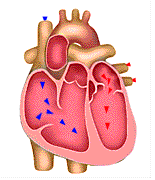|
|
|
As in prior
studies, stress nuclear scans were performed before and
after EECP, to document objectively that an improvement in blood flow
had occurred. A pre-EECP cardiac catheterization was also
carried out; the patients were classified as having one, two, or
three vessel coronary artery disease, depending on how many
arteries were blocked. The point of the study was to determine
if the number of vessels blocked could predict which patients
would improve the most with EECP. .
Dr. Lawson's
findings are presented in both graphic and table form
below. Before looking at this information, please take a
moment to think this over and predict what Dr. Lawson
found. Remember that EECP works by recruiting and then
enlarging collaterals from a good artery to a blocked
artery
EFFECT OF EECP ON NUCLEAR STRESS SCAN ABNORMALITIES |
|
#
Blocked Vessels |
Unimproved |
Less
Severe |
Normalized |
Improved |
|
One |
5% |
21% |
74% |
95% |
|
Two |
10% |
32% |
58% |
90% |
|
Three |
59% |
8% |
33% |
41% |

You were right.
When only one artery is blocked, we have two good arteries
to grow collaterals from, allowing us to "surround" the
blocked artery with an exuberant growth of collateral
vessels. A 95% scan improvement rate makes sense. These are
the patients who note a reduction in angina during their
second week of treatment. Conversely, when all three
arteries are blocked, we can grow collaterals only from the
diseased vessels themselves, proximal to their point of
obstruction. This gives us fewer potential collaterals to
work with, a less efficient ECP, and less complete
revascularization.
Keep in mind that
while the nuclear scan improved in only 41% of the patients
with three vessel disease, all of these patients experienced
a reduction in angina. Also, a 41% scan improvement rate is
better than no improvement at all in a patient with
persistent angina who cannot be treated with angioplasty or
bypass.
This study tells us that patients with one or two vessel
blockage, who are otherwise technically good candidates for
ECP, typically do well with ECP. Patients with three vessel
disease may improve, but here we expect less. In this
patient population, we might extend their course of ECP to
45 or 50 hours, to get the most we can out of this
technique. Of the first 50 patients to complete a full
course of EECP at our center, one man did not experience a
reduction in angina. Two others improved but died of
cardiovascular disease later on. All three had refractory
symptoms due to three vessel coronary disease, and were
undergoing ECP only because no other treatment options were
available.
|





